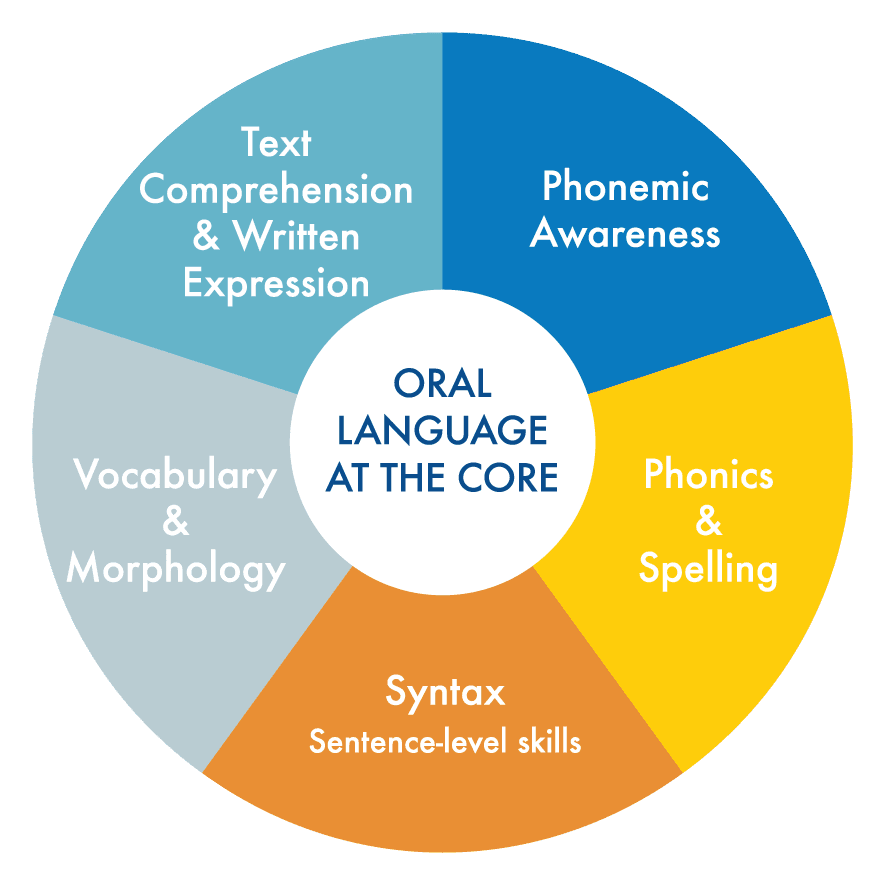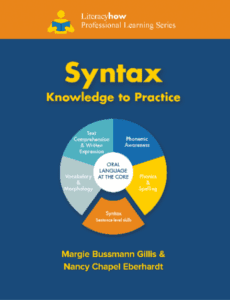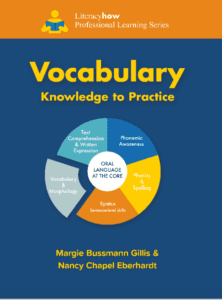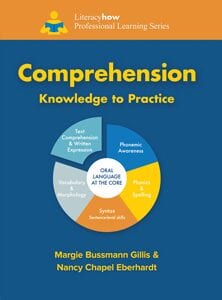
Syntax
What is it?
Syntax, a linguist’s word for sentence structures, is the rule system that governs how words and phrases are arranged into clauses and sentences. Grammar, though related, is not the same as syntax. It has to do with the function (i.e., role) of words and phrases in a sentence.

Syntax
What is it?
Syntax, a linguist’s word for sentence structures, is the rule system that governs how words and phrases are arranged into clauses and sentences. Grammar, though related, is not the same as syntax. It has to do with the function (i.e., role) of words and phrases in a sentence.
Frequently Asked Questions
Why teach Syntax?
Learning syntax and sentence structure helps students clarify meaning within and between sentences. Studies show a close relationship between an individual’s syntactic awareness and reading comprehension; that is, as students learn to use more complex sentences in oral and written language, their ability to make sense of what they read increases as well.
What is the relationship between syntax and grammar?
Grammar refers to a set of rules for a language, including how words and sentences are formed and standards for correct usage. Syntax is the arrangement of words and phrases to create well-formed sentences. One way to relate the two is to think of grammar being to syntax as what letters are to words (Eberhardt, Perspectives, 2013).
How important is it to teach the proper names of the parts of speech?
Teachers should begin grammar instruction with young children by talking about the function of words. Eventually, however, it is important to teach the proper grammatical terms (e.g., noun, adverb, etc.). When students are explicitly taught the names for the parts of speech using child-friendly language, then given practice applying these terms in oral language activities, there is a common language of instruction.
Teacher tip: Formal Frames
Start with oral language activities to develop syntactic awareness in order to improve sentence comprehension.
Use this formal frame activity to help students produce competent verbal or written responses. These begin as sentence starters, but add critical grammatical and lexical clarification and support.
teacher tip: Use syntax to gauge comprehension
Use your knowledge of syntax to anticipate which sentences in an assigned text will be difficult for students to comprehend. Keep in mind key factors that impact sentence complexity:
- Length
- Distance (i.e., number of words) between the subject and the verb; Number of clauses (especially embedded clauses)
- Advanced connectives that express more complicated relationships between sentence parts (e.g., however, despite, although)
- Passive vs. active voice (i.e., any exception to the common word order of English sentences)
- Pronoun references
- Less common verb tenses.
Teacher tip: Ask about word function
Teach students to ask a series of questions about the function of words that will help them label the ‘parts of speech’. For young children, we refer to the parts of speech as the building blocks of sentences. Here’s a sample sentence: Our wet, hairy dog crawled under my bed during the thunderstorm.
- Ask who or what did it? dog (looking for the namer/noun – the who/what)
- Ask what did it do? crawled (looking for the action word/verb – the do)
- Ask ‘how many, what kind, which one? wet, hairy (looking for adjectives describing the namer)
- Ask where, when,how, why? under the bed, during the thunderstorm (looking for adverbs that tell about the action)
Explicit instruction in function-based questions can improve both sentence-level comprehension and sentence writing.
Teacher tip: Teach syntax in Context
Evidence suggests that studying syntax and grammar out of context through rote memorization does not result in improved performance. Integrate syntax/grammar instruction into the revision and editing process. Pull individual sentences from students’ text as well as their writing to help them make sense of various sentence structures.
Read More to Learn More
- Cain, K. (Spring 2009). Making sense of text. Perspectives on Language and Literacy 35 (2), 11-14.
- Eberhardt, N.C. (Summer 2013). Syntax: Its role in literacy learning. Perspectives on Language and Literacy.
- Scott, C. M. (April 2009). A case for the sentence in reading comprehension. Language, Speech, and Hearing Services in Schools 40: 184-191.
- Steffani, S. (Spring 2007). Identifying embedded and conjoined complex sentences: Making it simple. Contemporary Issues in Communication Science and Disorders 34, 44-54.
Tips for Principals: PD Support
Provide adequate professional development time for teachers to learn how to observe students’ oral language behaviors and analyze their written expression for signs of difficulties with syntactic awareness and sentence level comprehension skills.
Tips for Principals: Support Text Analysis
Similarly, support teachers in their ability to analyze the texts that they’re assigning students so they can learn to identify sentences in a text that might pose the greatest challenge to reading comprehension.
Literacy How Professional Learning Series
The Literacy How Professional Learning Series translates the latest reading research into how-to instruction. The Knowledge to Practice book Series—Phonemic Awareness and Phonics, Syntax, Vocabulary, and Comprehension—is based on the current and comprehensive Literacy How reading model. It draws upon the authors’ decades of expertise and experience working with thousands of general and special education teachers. The Series emphasizes Pre-K-3rd grade conceptual and skill development. Teachers of older emerging or struggling readers will also find these tools useful.

Phonemic Awareness and Phonics—the keys to breaking the code!

Syntax is essential—even for beginning readers!

Vocabulary knowledge is essential for effective comprehension!

Comprehension is the goal of reading—even for beginning readers!